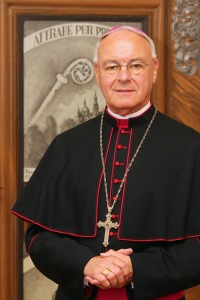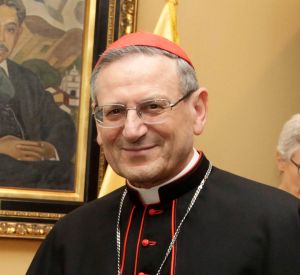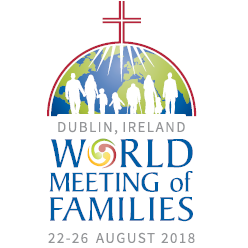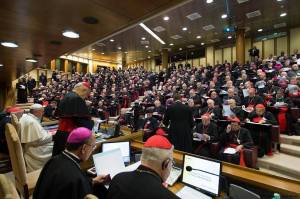On 27 August, Bishop Heinrich Timmerevers was installed as bishop of Dresden-Meißen. Here on the blog it went sort of unmarked because of the summer season, but here is the translation of the homily Bishop Timmervers gave on that day.
There are a few interesting comments to be found, not so much about the future direction he wishes to take in managing the diocese, but of a more theological nature. Comments about the centrality of the person of Jesus and our constant need to seek Him out, but also about what it means that we followed a resurrected Jesus, the need for vocations and recognising Jesus in the faces of the poor and needy.
 “Dear sisters and brothers here in the cathedral and in the courtyard!
“Dear sisters and brothers here in the cathedral and in the courtyard!
Dear fellow celebrants via the screens!
I.
The first encounters with faithful from our diocese took place during the Katholikentag in Leipzig. Various people often addressed me with the words, “Are you not our new bishop?” “Yes, I am!” We usually exchanged a few words and then I was often told, “We look forward to you very much!” – sometimes followed by the addition, “Hopefully you will stay a bit longer!” “That is what I’m expecting”, I answered.
Dear sisters and brothers! Since a few weeks my identity card includes the line ‘Schloßstrasse 24, 01067 Dresden’. I want to grow new roots here in the Diocese of Dresden-Meißen and make my home among you. The words I frequently heard – “We are happy with you!” – I gladly answer them now, “I am also happy you!”
II.
A person entering the cathedral is soon taken with the altar statue, created for this church by Anton Raphael Mengs in 1752. Christ, the crucified and risen one, is being taken up into heaven. It is an Ascension image.
In the reading we have just heard a part of the Letter from the Apostle Paul to the Colossians (3:1-4). They are the verses which we always hear on the feast of the Ascension of Christ: “If then you were raised with Christ, seek what is above, where Christ is seated at the right hand of God. Think of what is above, not of what is on earth.”
It seems a remarkable coincidence to me, that I chose my episcopal motto from these verses 15 years ago, and that it is now held up to use in the form of this great image. “Seek, where Christ is!”. “Think of what is above, not of what is on earth.” What is above is Christ. Jesus Christ, the Son of God, become man for us, crucified, died and buried, but then risen from the dead, He returns home to the Father. Through the Spirit, which He has poured out over the entire world, and which He continues to pour out, He is among us. This is the Jesus Christ with whom we are concerned, with whom Christians are concerned, He is the heart of our faith and life. This also seems a wonderful coincidence to me: Bishop Joachim chose the motto “Jesus in the centre”; Archbishop Heiner the motto “Rejoice always, the Lord is near!”. And I chose as motto: “Seek, where Christ is!” It is all about Him!
III.
Perhaps some would wonder, “Why should I seek Christ, what does that mean to me?” What it means to me, I have heard already in the first line of today’s reading: “You were raised with Christ!” One who is united to Christ through Baptism, has received a new life with Him, a life which does not end with death. Even more: the person baptised holds life within him, which today, now, gives us the strength and courage to face the challenges of life. Who seeks Jesus, finds direction for his life. Who seeks Jesus, finds clarity amid the many meanings presented by this world. Who seeks Jesus, finds with him the power of love, which conquers all division! Who seeks Jesus, finds a peace with Him, which the world can not give and no man can create! To quote Pope Benedict: “By relying on Jesus, you lose nothing, but gain everything!” You gain quality of life! How many of us, gathered here together, can say: It is worth seeking Jesus and entrusting yourself to Him!
IV.
Where do we find this Jesus Christ?
The statue of the Ascension in the cathedral provides an initial answer. The Church is the place of the risen, and indeed this, our Church, today, which constantly needs renewal and vitalisation through the Gospel. This Church, which has suffered under division since the Reformation, this Church, which every now and then can give a credible witness of love and mercy, this Church is the place of the Risen Lord! And in this Church the Lord is present in His Word, which is proclaimed and lived; He is present under the signs of bread and wine; He is present in the ministries of our Church. He is present when we come together in His name.
The faithful in the communities of the Diocese of Dresden-Meißen have, over the past years, been working with a process of exploration. What matters is to find ways in which as many people as possible in Saxony and eastern Thuringia can come to know and encounter Christ. I want to familiarise myself very soon with this process and I want – as soon as possible – to visit and get to know the responsible communities. I agree with the basic conviction of this process: the Church is the space of the Risen, the parish as the home of the Risen, the community coming together, is a place of the Risen! And then, dear sisters and brothers, the responsible communities established in this process of exploration will also be places of the Risen.
Amid all the questions and searching, with their arguments, clarifications and decisions, which must be made for a new structure for the pastoral care, and in trying to be a living and inviting Church, we all share the responsibility together to give the Risen One space among us. How can this be experienced?
The abbot of a great religious order told me that, when he would visit the various monasteries of the community, he would ask two question and speak with the monks about them. The first question: “Are you in the peace of the Risen One?” And the second question: “Do you have vocations?”
Dear sisters and brothers, I invite you to ask yourself these questions: “Are you in the peace of the Risen One, and do you have vocations?” In thinking about what the future will brign for our communities, what matter is that we create room among us for the Risen One! Who approaches Him in thought, question, search and in word and deed, will experience His peace.
The second question, “Do you have vocations?”, is internally connected to the first one! The Risen One calls people to be priests, religious. the Church needs these vocations! The Risen One calls the baptised and confirmed to come together with their gifts and abilities and work together on building up the Church! In the peace of the Rison One we can be Church together and have an effect on the world!
V.
The Church does not exist only for herself: we have been placed in the world, we live in it and with our lives we witness to the Good News! “Seek where Christ is!” Christ Himself shows us an even greater horizon, where we we look for and can find Him. In the Gospel that we hae just heard (Matt. 25:31-40), Jesus speaks about the final judgement and presents to us what will be asked then. These questions make our lives today very concrete!
Jesus says something unimaginable, He identifies Himself with the suffering and needy of this world. Whoever seeks Him, finds Him in the hungry, the thirst, the homeless, the naked, the sick and the imprisoned. He takes the suffering out of their anonymitym He gives them a face, His face! And so He can say, “Whatever you did for one of these least brothers of mine, you did for me”.
Christ broadens our horizon! Being Church and being Christian is not realised by staring at heaven, Christians do not remain within the churches, however beautiful these are! Being Christian means not being satisfied with looking inward in sacristies and parish houses! In seeking Christ we arrive at those who – for whatever reason – are in need! That is where we are all called!
Dear sisters and brothers, I invite you to go with me. Let us seek where Christ is!
I rejoice in you!
Amen!”
 A third auxiliary bishop for the German Diocese of Rottenburg-Stuttgart was appointed today. 50-year-old Msgr. Gerhard Schneider joins Auxiliary Bishops Thomas Renz and Matthaus Karrer, and ordinary Bishop Gebhard Fürst at the head of the diocese which covers the central and eastern parts of the state of Baden-Württemberg.
A third auxiliary bishop for the German Diocese of Rottenburg-Stuttgart was appointed today. 50-year-old Msgr. Gerhard Schneider joins Auxiliary Bishops Thomas Renz and Matthaus Karrer, and ordinary Bishop Gebhard Fürst at the head of the diocese which covers the central and eastern parts of the state of Baden-Württemberg.

 The retirement and appointment of bishops is pretty easy to predict, as bishops are legally bound to offer their resignation when they reach the age of 75. Locally, there are currently three dioceses without a bishop: Roermond in the Netherlands, and Hildesheim and Würzburg in Germany. In 2018, two more will likely join these: in Fulda, Bishop Heinz Josef Algermissen (at right) will celebrate his 75th on 15 February, and in Namur, Bishop Remy Vancottem will do likewise on 25 July. A third likely diocese to fall vacant in Ghent. Bishop Luc van Looy will turn 77 on 28 September. Upon his 75th birthday, the diocese made it known that Pope Francis had requested the bishop stay on for two more years, and that extension is up this year.
The retirement and appointment of bishops is pretty easy to predict, as bishops are legally bound to offer their resignation when they reach the age of 75. Locally, there are currently three dioceses without a bishop: Roermond in the Netherlands, and Hildesheim and Würzburg in Germany. In 2018, two more will likely join these: in Fulda, Bishop Heinz Josef Algermissen (at right) will celebrate his 75th on 15 February, and in Namur, Bishop Remy Vancottem will do likewise on 25 July. A third likely diocese to fall vacant in Ghent. Bishop Luc van Looy will turn 77 on 28 September. Upon his 75th birthday, the diocese made it known that Pope Francis had requested the bishop stay on for two more years, and that extension is up this year. While all hold memberships in various dicasteries in the curia, two of these sit at the head of them: Cardinal Coccopalmerio is president of the Pontifical Council for Legislative Texts and Cardinal Amato (at left) is the prefect of the Congregation for the Causes of Saints. Cardinal Nguyễn Văn Nhơn remains active as archbishop of Hanoi. All will undoubtedly retire upon their 80th birthday, opening up some interesting positions in the curia. Barring any deaths, the number of cardinal electors will stand at 114 by mid-2018. Possibly not low enough for a new consistory by itself, but considering the fact that a further 10 ill age out in 2019, Pope Francis may decide to be proactive and call a consistory in autumn for the creation of anywhere between 6 and 16 new cardinals.
While all hold memberships in various dicasteries in the curia, two of these sit at the head of them: Cardinal Coccopalmerio is president of the Pontifical Council for Legislative Texts and Cardinal Amato (at left) is the prefect of the Congregation for the Causes of Saints. Cardinal Nguyễn Văn Nhơn remains active as archbishop of Hanoi. All will undoubtedly retire upon their 80th birthday, opening up some interesting positions in the curia. Barring any deaths, the number of cardinal electors will stand at 114 by mid-2018. Possibly not low enough for a new consistory by itself, but considering the fact that a further 10 ill age out in 2019, Pope Francis may decide to be proactive and call a consistory in autumn for the creation of anywhere between 6 and 16 new cardinals. Speaking about the pope, he will, despite the fact that he has no love for travelling, visit several countries in 2018. In January, he will once again return to South America, visiting Peru and Chile. Ireland is on the schedule in August, when the Holy Father will attend the World Meeting of Families taking place in Dublin (logo at right). Visits not yet confirmed are to the Baltic countries in September and to Romania in December. A visit to India also remains an option, but as Pope Francis has just wrapped a visit to India’s neighbouring countries of Myanmar and Bangladesh, it may not be at the top of the list.
Speaking about the pope, he will, despite the fact that he has no love for travelling, visit several countries in 2018. In January, he will once again return to South America, visiting Peru and Chile. Ireland is on the schedule in August, when the Holy Father will attend the World Meeting of Families taking place in Dublin (logo at right). Visits not yet confirmed are to the Baltic countries in September and to Romania in December. A visit to India also remains an option, but as Pope Francis has just wrapped a visit to India’s neighbouring countries of Myanmar and Bangladesh, it may not be at the top of the list. In the latter part of the year, all eyes will be on the Synod of Bishops again, this while the reverberations of the last two assemblies of that body are still being felt. The October 2018 Fifteenth Ordinary General Assembly of the Synod of Bishops while focus on “Young People, Faith and Vocational Discernment”. To this assembly, each bishops’ conference will elect one or more (depending on their size) delegates, while the Pope will also make a personal selection of delegates. One of these personal choices has already been made: Sérgio Cardinal Da Rocha, the archbishop of Brasília, was appointed as Relator General of next year’s assembly. He will outline the theme at the start of the assembly and summarise the delegates’ speeches so they can be condensed into concrete proposals.
In the latter part of the year, all eyes will be on the Synod of Bishops again, this while the reverberations of the last two assemblies of that body are still being felt. The October 2018 Fifteenth Ordinary General Assembly of the Synod of Bishops while focus on “Young People, Faith and Vocational Discernment”. To this assembly, each bishops’ conference will elect one or more (depending on their size) delegates, while the Pope will also make a personal selection of delegates. One of these personal choices has already been made: Sérgio Cardinal Da Rocha, the archbishop of Brasília, was appointed as Relator General of next year’s assembly. He will outline the theme at the start of the assembly and summarise the delegates’ speeches so they can be condensed into concrete proposals. “Today is the start of Advent, the period of preparation before Christmas. We celebrate that the Lord has come, but also that He is the one who is coming. We speak of a double, or even triple, coming. This thought is dear to me and nourishes my faith life.
“Today is the start of Advent, the period of preparation before Christmas. We celebrate that the Lord has come, but also that He is the one who is coming. We speak of a double, or even triple, coming. This thought is dear to me and nourishes my faith life.
 “Dear sisters and brothers here in the cathedral and in the courtyard!
“Dear sisters and brothers here in the cathedral and in the courtyard! Heinrich Timmerevers was born in the small town of Garrel, southwest of Oldenburg, as second of six children in a farmer’s family, and attended school in nearby Cloppenburg, where he graduated in 1972. he studied theology and philosophy in Münster, where he also entered the seminary. For a short time he studied in Freiburg, but returned to Münster for his graduation in 1977. In 1997 and 1978 he attended a spirituality course of the Focolare movement, which he got to know in seminary, in Rome.
Heinrich Timmerevers was born in the small town of Garrel, southwest of Oldenburg, as second of six children in a farmer’s family, and attended school in nearby Cloppenburg, where he graduated in 1972. he studied theology and philosophy in Münster, where he also entered the seminary. For a short time he studied in Freiburg, but returned to Münster for his graduation in 1977. In 1997 and 1978 he attended a spirituality course of the Focolare movement, which he got to know in seminary, in Rome. Bishop Timmerevers will be the ninth bishop of Dresden-Meißen since the diocese restoration in 1921. The diocese is located in eastern Germany along the Czech border, covering most of the state of Saxony and small parts of Thuringia and is part of the Church Province of Berlin, togetehr with the Diocese of Görlitz and the Archdiocese of Berlin. With the appointment of Bishop Timmerevers, all these sees are filled again. In Germany, the dioceses of Aachen and Limburg now remain vacant.
Bishop Timmerevers will be the ninth bishop of Dresden-Meißen since the diocese restoration in 1921. The diocese is located in eastern Germany along the Czech border, covering most of the state of Saxony and small parts of Thuringia and is part of the Church Province of Berlin, togetehr with the Diocese of Görlitz and the Archdiocese of Berlin. With the appointment of Bishop Timmerevers, all these sees are filled again. In Germany, the dioceses of Aachen and Limburg now remain vacant. The old debate about the number of seminaries in the Netherlands was restarted this week as the rectors of two of them – Fathers Jan Vries of Rolduc (Diocese of Roermond) and Gerard Bruggink (pictured at right) of the Tiltenberg (D. of Haarlem-Amsterdam) – both suggested that the Church in this country would be better served by having a single seminary for the entire Province, instead of the six that exist now.
The old debate about the number of seminaries in the Netherlands was restarted this week as the rectors of two of them – Fathers Jan Vries of Rolduc (Diocese of Roermond) and Gerard Bruggink (pictured at right) of the Tiltenberg (D. of Haarlem-Amsterdam) – both suggested that the Church in this country would be better served by having a single seminary for the entire Province, instead of the six that exist now. Most seminary rectors are in favour of merging the existing seminaries into one or two. Father Patrick Kuipers of the recently re-established Ariëns Institute (seminary building pictured at left), Archdiocese of Utrecht, says, “Personally, I am very much in favour of it. I think that the group of seminarians in the Netherlands is too small to be spread out over five or six institutes.” He thinks a group of 25 would be ideal, because that would form a true community. Father Norbert Schnell, of Bovendonk, relates that German colleagues say that 20 seminarians is the minimum required.
Most seminary rectors are in favour of merging the existing seminaries into one or two. Father Patrick Kuipers of the recently re-established Ariëns Institute (seminary building pictured at left), Archdiocese of Utrecht, says, “Personally, I am very much in favour of it. I think that the group of seminarians in the Netherlands is too small to be spread out over five or six institutes.” He thinks a group of 25 would be ideal, because that would form a true community. Father Norbert Schnell, of Bovendonk, relates that German colleagues say that 20 seminarians is the minimum required. Odd one out among the rectors is Fr. Filip De Rycke of the St. John’s Centre in Den Bosch. He admits that “sharing” teachers is a burden on people and that a larger group of students is better. But he also looks to Flanders, where all dioceses, apart from Bruges, joined forces. There is no outpouring of vocations there either, he states.
Odd one out among the rectors is Fr. Filip De Rycke of the St. John’s Centre in Den Bosch. He admits that “sharing” teachers is a burden on people and that a larger group of students is better. But he also looks to Flanders, where all dioceses, apart from Bruges, joined forces. There is no outpouring of vocations there either, he states.